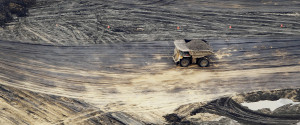Canada's most contaminated site, the Yellowknife Giant Mine, has reached a milestone in its $1 billion taxpayer-funded remedial plan. The dangerous and badly contaminated roaster building, which created hundreds of thousands of tonnes of highly poisonous arsenic trioxide, (enough to kill every human in the world) has finally been demolished.
Between 1948 and 2004, the Giant Mine was a major economic driver for Yellowknife and the Northwest Territories. When the mine closed, bankrupt, after bitter battles with its union and an explosion, it left behind an environmental catastrophe, including 237,000 tonnes of arsenic trioxide in underground chambers. The original concept (approved by mining regulators) had been that permafrost would naturally keep the poisonous dust frozen. It didn't happen. Why? The heat of the mine operations themselves; infiltrating water; huge open pits that (with regulators' permission) were dug nearby; and climate change.
On August 14, 2014, after a very difficult and contentious environmental assessment, the federal government approved a controversial remedial plan to (hopefully) contain the arsenic trioxide in place for (at least) a hundred years. The decision of the Minister of Aboriginal Affairs and Northern Development (AANDC), on behalf of the Responsible Ministers for this project, is available at Report of Environmental Assessment (EA). Other approvals still needed include a water licence from the Mackenzie Valley Land and Water Board, (which triggered the entire environmental assessment); a decision on the possible re-routing of Baker Creek which crosses the site, possible municipal approvals, and establishing a community board to supervise the remediation.
The approved EA measures are very complex, and will include freezing in place the huge underground dumps of arsenic trioxide which pose the greatest health risk. (It is likely to take 25 years to freeze it all. The freezing system will have to be actively operated, forever. The arsenic will stay poisonous -- it does not improve with time.)
Above ground, one of the top priorities has been to pull down ("deconstruct") the huge roaster complex. Its high concentrations of arsenic dust and asbestos made it one of the most contaminated areas on the site, and therefore in all of Canada.
On October 31, @GiantMine tweeted "The final roaster complex structure is down. The deconstruction project is nearly complete. #yzf http://ow.ly/DE1zW". The project team anticipates that the full roaster deconstruction project -- including the removal of heavy machinery and other wrap-up activities -- will be complete by March of 2015. Work is underway to design and implement other parts of the remedial plan, including the freezing program.
The $1 billion remediation of the Giant Mine will consume a large fraction of the federal government's Federal Contaminated Sites Action Plan. This means that many lesser, but still dangerous, site cleanups, will be left unfunded. It also means that Canadian taxpayers will pay much more to control the Giant Mine site than the total royalties ever received from the mine. I suspect the same is true for the Sydney Tar Ponds.
Are we making the same mistakes again with the oil sands?
Original Article
Source: huffingtonpost.ca/
Author: Dianne Saxe
Between 1948 and 2004, the Giant Mine was a major economic driver for Yellowknife and the Northwest Territories. When the mine closed, bankrupt, after bitter battles with its union and an explosion, it left behind an environmental catastrophe, including 237,000 tonnes of arsenic trioxide in underground chambers. The original concept (approved by mining regulators) had been that permafrost would naturally keep the poisonous dust frozen. It didn't happen. Why? The heat of the mine operations themselves; infiltrating water; huge open pits that (with regulators' permission) were dug nearby; and climate change.
On August 14, 2014, after a very difficult and contentious environmental assessment, the federal government approved a controversial remedial plan to (hopefully) contain the arsenic trioxide in place for (at least) a hundred years. The decision of the Minister of Aboriginal Affairs and Northern Development (AANDC), on behalf of the Responsible Ministers for this project, is available at Report of Environmental Assessment (EA). Other approvals still needed include a water licence from the Mackenzie Valley Land and Water Board, (which triggered the entire environmental assessment); a decision on the possible re-routing of Baker Creek which crosses the site, possible municipal approvals, and establishing a community board to supervise the remediation.
The approved EA measures are very complex, and will include freezing in place the huge underground dumps of arsenic trioxide which pose the greatest health risk. (It is likely to take 25 years to freeze it all. The freezing system will have to be actively operated, forever. The arsenic will stay poisonous -- it does not improve with time.)
Above ground, one of the top priorities has been to pull down ("deconstruct") the huge roaster complex. Its high concentrations of arsenic dust and asbestos made it one of the most contaminated areas on the site, and therefore in all of Canada.
On October 31, @GiantMine tweeted "The final roaster complex structure is down. The deconstruction project is nearly complete. #yzf http://ow.ly/DE1zW". The project team anticipates that the full roaster deconstruction project -- including the removal of heavy machinery and other wrap-up activities -- will be complete by March of 2015. Work is underway to design and implement other parts of the remedial plan, including the freezing program.
The $1 billion remediation of the Giant Mine will consume a large fraction of the federal government's Federal Contaminated Sites Action Plan. This means that many lesser, but still dangerous, site cleanups, will be left unfunded. It also means that Canadian taxpayers will pay much more to control the Giant Mine site than the total royalties ever received from the mine. I suspect the same is true for the Sydney Tar Ponds.
Are we making the same mistakes again with the oil sands?
Original Article
Source: huffingtonpost.ca/
Author: Dianne Saxe

No comments:
Post a Comment